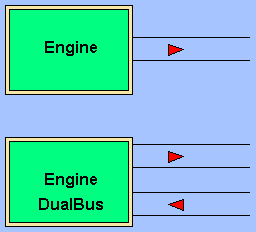 |
|
|
|
In the Forums... |
Posted: April 25, 2000 Written by: Tuan "Solace" Nguyen Note: This preview was written April 20th. Some data/facts may become inaccurate as new information becomes available. 256-bit DualBus What's a bus? What's a DualBus? You can think of a bus as being a highway for data to travel to and from components. Taking into account that the word Dual means two, we now have two buses. Didn't the G200 have a DualBus also? Yes. But it was 128-bit, comprised of two 64-bit buses. The G450 contains two 128-bit buses. This technology will surely prep the G450 for the future and keep it a step away from being the next bargain-bin card. This technology is also available on the G400, which is what made it such a competitive and speedy card. Data on the bus normally goes in one direction. But the bus is bi-directional. During any given clock cycle, data may go from the graphics engine or to the graphics engine. So technically only one thing can be done at a time. But Matrox took a different approach and split the bus into two - hence the name DualBus. One bus goes from the graphics engine and the other goes to the graphics engine. So now data can go in and out at the same time. The spark here is that both buses are 128-bits wide, producing and total bus width of 256-bits! This is extremely efficient, and theoretically the card can pump out double the performance. Working in tandem with the DualBus architecture, the graphics engine can make sure both buses are doing what they should respectively be doing. Instead of waiting for in-data to finish to go out, in-data and out-data can be active at the same time and not saturate the bus.
Speaking of Bus, What About AGP? The G450 is AGP 1x/2x/4x compliant with AGP texturing and sideband support. Also, in conjunction with a technology called Symmetric Rendering Architecture (SRA), the G450 will be able to handle upcoming titles with ease. SRA or Symmetric Rendering Architecture, is a method of using fast AGP (4x and above) to store textures efficiently. It will place small and frequently used textures in the local onboard RAM and place large, less frequently used textures in AGP memory where plenty is available. Since AGP 4x's peak bandwidth of 1.06GB/s is double what it is now, faster RAM will bridge the gap between local memory speed and AGP memory speed. |
||||
|
| |||||
|---|---|---|---|---|---|
